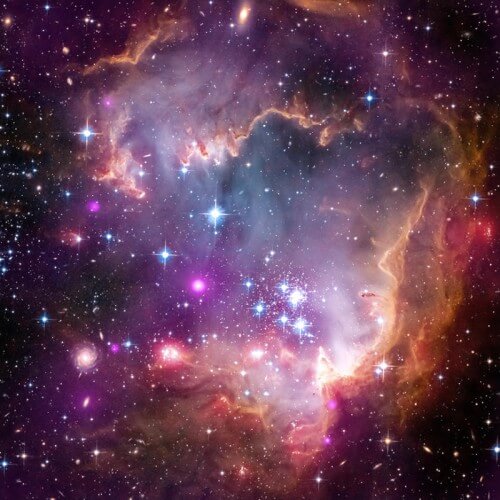New data on the Small Magellanic Cloud provided by the Chandra Space Telescope provide the first detection of X-rays from young, solar-mass stars outside the Milky Way.

The Small Magellanic Cloud is one of the Milky Way's closest galactic neighbors. Although it is a small galaxy or as it is called a dwarf galaxy, the Small Magellanic Cloud is a galaxy so bright that it can be seen with the naked eye in the southern hemisphere and near the equator. Many sailors, including Ferdinand Magellan who gave his name to the galaxy, used it to find their way in the oceans.
Modern astronomers have been interested in the study of the Magellanic Clouds (the Small and its brother the Large Magellanic Cloud), but for completely different reasons. Because the Small Magellanic Cloud is so close and bright, it provides an opportunity to study phenomena that are difficult to study in more distant galaxies.
New data on the Small Magellanic Cloud provided by the Chandra Space Telescope provide the first detection of X-rays from young, solar-mass stars outside the Milky Way. Chandra's new observations of low-mass stars were made in a region known as the "wing of the Small Magellanic Cloud". In this composite image of the wing, Chandra data is shown in purple, optical data from the Hubble Space Telescope is colored in red, green and blue. Infrared radiation data from the Spitzer Space Telescope are also represented in red.
Astronomers call all elements heavier than hydrogen or helium, (meaning they have more than two protons in the atomic nucleus) - 'metals'. The wing is an area that is known for the scarcity of metals compared to most areas in the Milky Way. The wing also has a relatively low abundance of gas, dust and stars compared to the Milky Way.
Together, these features make the wing an excellent place to study the life cycle of stars and the gas that resides between them. Not only are these conditions typical of small, irregular galaxies like the Small Magellanic Cloud, they also mimic conditions that might have existed in the early universe.
Most of the star regions near the tip of the wing are in a small region known as NGC 602, which contains a collection of at least three star clusters. One of them, NGC 602a, is similar in age, mass and size to the cluster in the Orion Nebula. The researchers studied NGC 602a to see if young stars – that is, a few million years old at most – have different properties than usual because of the low metal levels, such as that found in NGC 602a.
Using Chandra, astronomers discovered X-rays emanating from two dense regions of stars in NGC 602a. The persistent X-ray cloud likely comes from a population of young, low-mass stars in the cluster, which could not be discerned in infrared and optical surveys using Spitzer and Hubble respectively. The emissions are unlikely to be gas drifting away due to the proximity of large stars because the low metal content of the stars in NGC 602a means that these stars produce a relatively weak 'solar wind'.
The failure to detect X-rays from most of the massive stars in NGC 602a supports this conclusion because X-rays are a marker of the strength of the solar wind blowing from the massive stars. No star with a mass lower than a certain value has been discovered, but the overlapping radiations of several thousand stars are bright enough to be detected.
Chandra's images show that the low-mass stars in NGC 602a produce X-rays in a similar way to more metal-rich stars like the one in our galaxy's Orion cluster. The authors of the study estimate that if the X-ray properties of the young stars are similar in different environments, it is possible that other properties related to this radiation - including the creation and development of disks from which planets are formed, are also expected to be similar.
X-ray emission follows the magnetic activity of young stars and is related to the efficiency of their magnetic dynamo. The magnetic dynamos create magnetic fields in the stars through a process related to the rotation speed of the star, the ability to conduct magnetism as well as the turbulent currents of hot gas inside the star.
The combination of X-rays, and data from optical and infrared observations reveals, for the first time outside our galaxy, objects that represent younger stages of a star's development, called "young stellar objects" that are only a few thousand years old and which are still associated with the column of gas and cloud in which they were formed, such as the "Pillar of Creation" ” famous in the Eagle Nebula.

One response
Anyone who has abused you can create a chain reaction of nanotechnology that creates as many little people as possible stuck inside atoms with mini ovens for billions of years